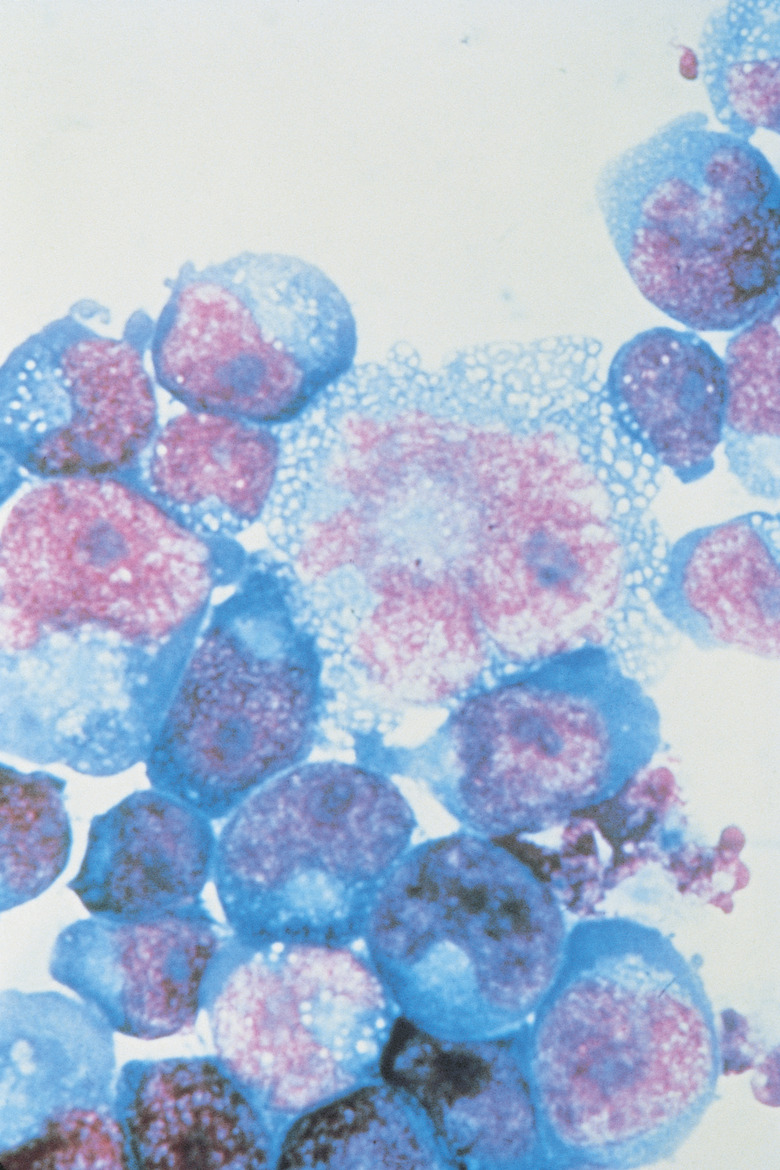Function Of T-Cells In The Thymus Gland
Located just below the breastbone, or sternum, and above the heart, the H-shaped thymus gland is a lymphoid system organ active in the body's immune system. It is largest during childhood and puberty, becoming smaller with age, until in old age, it is mostly replaced by fatty tissue. T-cells start as undifferentiated white blood cells called lymphocytes in bone marrow. They travel through the blood system to the thymus, where they mature into T-cells that defend against viruses, bacteria, fungi and other diseases.
Arrival At the Thymus
Arrival At the Thymus
Lymphocytes move into the cortex of the thymus. Here epithelial reticular cells, also called thymic nurse cells, surround the lymphocytes. The nurse cells select and transform lymphocytes into T-cells, which stands for thymus derived cells. The function of the T-cells within the thymus is to undergo the selection and maturation process that turns them into immune system components. The transformation process is complex and takes about a month. The thymus is like a training school for lymphocytes, and only about 95 percent of the entering lymphocytes make it through.
Potential T-Cell Selection
Potential T-Cell Selection
After entering the thymic cortex, an isolation barrier of several types of thymus cells surrounds the potential T-cells. The barrier prevents exposure to the body's own cells so that the undifferentiated lymphocytes don't become sensitized to them. After barrier formation, the nurse cells test the developing T-cells by exposing them to foreign and self antigens. The lymphocytes that can't recognize foreign antigens or do recognize self-antigens are negatively selected and get killed by macrophages, another kind of white blood cell. The lymphocytes that recognize foreign antigens survive and undergo further training.
Further Specialization
Further Specialization
Once selected as possible T-cells, lymphocytes further develop by exposure to many kinds of molecules secreted by groups of epithelial cells within the medulla areas of the thymus. By repeated chemical signaling between nurse cells and lymphocytes, lymphocytes progressively develop into three basic types of specialized immune system T-cells. Unlike generalized white blood cells — such as macrophages, which attack a wide range of antigen-producing pathogens — the T-cells respond to only a single antigen, such as one specific virus type or a given strain of bacteria. Since there are so many possible infectious agents, it's estimated that a thymus produces 25 million to a billion different T-cells.
Final Forms
Final Forms
After T-cells have responded to the selection and training within the thymus, three basic types result: cytotoxic, helper and regulatory T-cells. Cytotoxic T-cells, or killer T-cells, have a lock-and-key arrangement with a specific antigen bound to a normal component of cells known as a major histocompatibility complex. They lock on to the antigen they're programmed for and kill the infected cell. Helper T-cells don't attack or kill invaders, but act as coordinators between other immune system components. Regulatory T-cells result from modification by rounded thymus structures called Hassall's corpuscles. The corpuscles identify rejected T-cells that were found to attack the body's own tissues, but somehow didn't get killed, and turns them into policemen cells that destroy other rogue rejected cells that would otherwise cause autoimmune problems. Once the T-cells mature, they enter the blood stream and the lymph nodes to do their jobs.
References
- The Johns Hopkins Atlas of Human Functional Anatomy; Leon Schlossberg, George D. Zuidema
- Clinical & Experimental Immunology: Miller's Seminal Studies on the Role of Thymus in Immunity; D. Ribatti, E. Crivellato, and A. Vacca
- Encyclopedia Britannica: Lymphatic System
- DiFiore's Atlas of Histology with Functional Correlations; Victor P. Eroschenko, Mariano S. H. di Fiore
- Endocrine Awareness Center for Health: The Thymus Glands
- ABC Australia: RadioNational: The Science Show: The Thymus Gland: Where T Cells Are Made and Taught
- International Journal of Biochemical Cell Biology: Cells in Focus: Endothelial Cell
- Arizona State University School of Life Sciences: Ask A Biologist: Viral Attack: T-Cells
Cite This Article
MLA
Csanyi, Carolyn. "Function Of T-Cells In The Thymus Gland" sciencing.com, https://www.sciencing.com/function-tcells-thymus-gland-10638/. 24 April 2017.
APA
Csanyi, Carolyn. (2017, April 24). Function Of T-Cells In The Thymus Gland. sciencing.com. Retrieved from https://www.sciencing.com/function-tcells-thymus-gland-10638/
Chicago
Csanyi, Carolyn. Function Of T-Cells In The Thymus Gland last modified March 24, 2022. https://www.sciencing.com/function-tcells-thymus-gland-10638/
